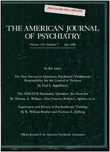Generalized anxiety and generalized anxiety disorder: description and reconceptualization
Abstract
One hundred eight patients complaining of anxiety were diagnosed using the Anxiety Disorders Interview Schedule and classified into the various anxiety disorder categories as well as major depression. Although patients with a primary diagnosis of generalized anxiety disorder were more chronic than were panic disorder patients, most patients in each category met the DSM-III criteria for generalized anxiety disorder with the exception of simple phobic patients. On the basis of these data, it would seem that generalized anxiety disorder is a residual category within the anxiety disorders, since generalized anxiety disorder symptoms are almost always present. But if one distinguishes anticipatory anxiety, which is often part of panic or phobic disorders, from generalized anxiety, an independent anxiety disorder category emerges. This category is characterized by apprehensive expectation or chronic worry focused on multiple life situations.
Access content
To read the fulltext, please use one of the options below to sign in or purchase access.- Personal login
- Institutional Login
- Sign in via OpenAthens
- Register for access
-
Please login/register if you wish to pair your device and check access availability.
Not a subscriber?
PsychiatryOnline subscription options offer access to the DSM-5 library, books, journals, CME, and patient resources. This all-in-one virtual library provides psychiatrists and mental health professionals with key resources for diagnosis, treatment, research, and professional development.
Need more help? PsychiatryOnline Customer Service may be reached by emailing [email protected] or by calling 800-368-5777 (in the U.S.) or 703-907-7322 (outside the U.S.).



